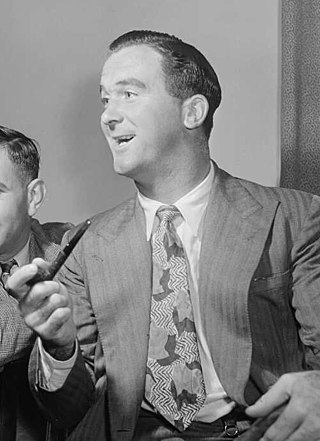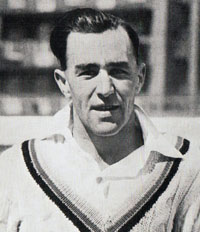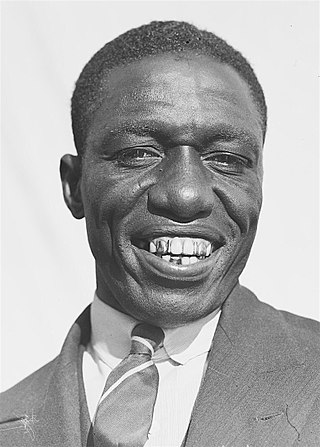
Sir Leonard Hutton was an English cricketer. He played as an opening batsman for Yorkshire County Cricket Club from 1934 to 1955 and for England in 79 Test matches between 1937 and 1955. Wisden Cricketers' Almanack described him as "one of the greatest batsmen in the history of cricket". He set a record in 1938 for the highest individual innings in a Test match in only his sixth Test appearance, scoring 364 runs against Australia, a milestone that stood for nearly 20 years. Following the Second World War, he was the mainstay of England's batting. In 1952, he became the first professional cricketer of the 20th century to captain England in Tests; under his captaincy England won the Ashes the following year for the first time in 19 years.

Walter Reginald Hammond was an English first-class cricketer who played for Gloucestershire in a career that lasted from 1920 to 1951. Beginning as a professional, he later became an amateur and was appointed captain of England. Primarily a middle-order batsman, Wisden Cricketers' Almanack described him in his obituary as one of the four best batsmen in the history of cricket. He was considered to be the best English batsman of the 1930s by commentators and those with whom he played; they also said that he was one of the best slip fielders ever. Hammond was an effective fast-medium pace bowler and contemporaries believed that if he had been less reluctant to bowl, he could have achieved even more with the ball than he did.

Norman Walter Dransfield Yardley was an English cricketer who played for Cambridge University, Yorkshire County Cricket Club and England, as a right-handed batsman and occasional bowler. An amateur, he captained Yorkshire from 1948 to 1955 and England on fourteen occasions between 1947 and 1950, winning four Tests, losing seven and drawing three. Yardley was named Wisden Cricketer of the Year in 1948, and in his obituary in Wisden Cricketers' Almanack he was described as Yorkshire's finest amateur since Stanley Jackson.

Thomas Godfrey Evans was an English cricketer who played for Kent and England. Described by Wisden as 'arguably the best wicket-keeper the game has ever seen', Evans collected 219 dismissals in 91 Test match appearances between 1946 and 1959 and a total of 1066 in all first-class matches. En route he was the first wicket keeper to reach 200 Test dismissals and the first Englishman to reach both 1000 runs and 100 dismissals and 2000 runs and 200 dismissals in Test cricket. He was a Wisden Cricketer of the Year in 1951.
Seymour MacDonald Nurse was a Barbadian cricketer. Nurse played 29 Test matches for the West Indies between 1960 and 1969. A powerfully built right-hand batsman and an aggressive, if somewhat impetuous, shotmaker, Nurse preferred to bat in the middle order but was often asked to open the batting. A relative latecomer to high-level cricket, Nurse's Test cricket career came to what many consider a premature end in 1969.

Herbert Wilfred Taylor was a South African cricketer who played 42 Test matches for his country including 18 as captain of the side. Specifically a batsman, he was an expert on the matting pitches which were prevalent in South Africa at the time and scored six of his seven centuries at home. His batting was also noted for quick footwork and exceptional 'backplay'. He became the first South African to pass 2,500 Test runs and was selected one of Wisden's Cricketers of the Year in 1925. In domestic cricket, he played for Natal, Transvaal and Western Province.

Geoffrey Bevington Legge was an English first-class cricketer who played in five Test matches between 1927 and 1930. He was born at Bromley, Kent and died at Brampford Speke, Devon in a flying accident while serving in the Fleet Air Arm during World War II.
Fred Barratt played first-class cricket for Nottinghamshire County Cricket Club from 1914 to 1931 and represented England in five Test matches, one in the home series against South Africa in 1929 and four on the inaugural Test series against New Zealand in the 1929–30 season. He was born in Annesley, Nottinghamshire and died at Nottingham General Hospital, Nottingham.

William Gilbert Anthony Parkhouse was a Welsh cricketer who played in seven Tests for England in 1950, 1950–51 and 1959.

George Nathaniel Francis was a West Indian cricketer who played in West Indies' first Test in their inaugural Test tour of England. He was a fast bowler of renowned pace and was notably successful on West Indies' non-Test playing tour of England in 1923, but he was probably past his peak by the time the West Indies were elevated to Test status. He was born in Trents, St. James, Barbados and died at Black Rock, Saint Michael, also in Barbados.
Robert Hector Catterall was a South African cricketer who played in 24 Test matches from 1922 to 1931.
An England team toured Australia between November 1920 and March 1921. The tour was organised by the Marylebone Cricket Club and matches outside the Tests were played under the MCC name. The tour itinerary consisted of 13 first-class matches, including a series of 5 Test matches against Australia in which The Ashes were at stake.
The England cricket team toured Australia in the 1936–37 season to play a five-match Test series against Australia for The Ashes. The tour was organised by the Marylebone Cricket Club and matches outside the Tests were played under the MCC name.

The England cricket team toured Australia and New Zealand between October 1962 and March 1963 with a one-match stopover in Colombo, en route to Australia. The tour was organised by Marylebone Cricket Club (MCC) and, in all matches other than Tests, the team was called MCC. In Australia, the tour itinerary consisted of 15 first-class matches, including the five-match Test series against Australia in which The Ashes were at stake. It was the last England cricket tour of Australia where the team travelled by ship.
The England cricket team toured South Africa in the 1956–57 season. The tour was organised by the Marylebone Cricket Club and the side played five Test matches as "England" and 15 other first-class matches as "MCC". Two of the first-class matches took place in Rhodesia in what is now Zimbabwe.
The New Zealand national cricket team toured South Africa from October 1961 to February 1962 and played a five-match Test series against the South Africa national cricket team. The series was drawn 2–2, with New Zealand's victory in the third Test the team's first Test match win outside their home country. New Zealand captain John Reid scored a total of 1,915 runs during the tour, setting a record for the most runs scored in South Africa by a touring batsman. The tour was the second to South Africa by a team from New Zealand, the previous tour having taken place in 1953–54.

A cricket team representing England toured Australia in the 1932–33 season. The tour was organised by the Marylebone Cricket Club and matches outside the Tests were played under the MCC name. The tour included five Test matches in Australia, and England won The Ashes by four games to one. The tour was highly controversial because of the bodyline bowling tactics used by the England team under the captaincy of Douglas Jardine. After the Australian tour was over, the MCC team moved on to play in New Zealand, where two further Test matches were played.
This article describes the history of New Zealand cricket from the 1918–19 season until 1945.
This article describes the history of New Zealand cricket from the 1945–46 season until 1970.
The English cricket team's tour to Australia in 1903–04 was the first time the Marylebone Cricket Club (MCC) took over responsibility for sponsoring and arranging an overseas tour representing England. England had not won the Ashes since the 1896 series in England. The MCC appointed Plum Warner to put together and captain a team, which was very much seen as the underdogs against Australia. Warner and his team, however, pulled off the upset the English were looking for and won the five-Test series 3–2. In the first Test at Sydney, R.E. "Tip" Foster scored 287 to set the world record for the highest individual Test innings; the innings remains the highest by a Test debutant.









